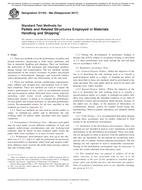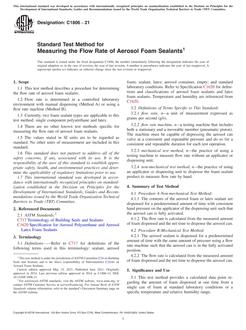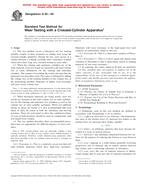1.1 This test method covers a four-stroke cycle diesel engine test procedure for evaluating engine oils for certain high-temperature performance characteristics, particularly ring sticking, ring and cylinder wear, and accumulation of piston deposits. Such oils include both single viscosity SAE grade and multiviscosity SAE grade oils used in diesel engines. It is commonly known as the 1M-PC test (PC for Pre-Chamber) and is used in several API oil categories, notably the CF and CF-2 and the military category described in MIL-PRF-2104 (see Note 1).
Note 1 – Companion test methods used to evaluate other engine oil performance characteristics for API oil categories CF and CF-2 are discussed in SAE J304. The companion tests used by the military can be found in MIL-PRF-2104.
1.2 The values stated in SI units are to be regarded as standard. The values in parentheses are provided for information only.
1.3 This standard does not purport to address all of the safety concerns, if any, associated with its use. It is the responsibility of the user of this standard to establish appropriate safety and health practices and determine the applicability of regulatory limitations prior to use.
1.4 This test method is arranged as follows:
| TABLE OF CONTENTS | ||
| Scope | 1 | |
| Reference Documents | 2 | |
| Terminology | 3 | |
| Summary of Test Method | 4 | |
| Significance and Use | 5 | |
| Apparatus | 6 | |
| Test Engine | 6.1 | |
| Engine Accessories | 6.2-6.14 | |
| Engine Oil System | 6.15 | |
| Cooling System | 6.16 | |
| Fuel System | 6.17 | |
| Intake Air System | 6.18 | |
| Exhaust System | 6.19 | |
| Blowby Meter | 6.20 | |
| Thermocouples | 6.21 | |
| Parts | 6.22 | |
| Instrumentation | 6.23 | |
| Crankcase Paint | 6.24 | |
| Reagents and Materials | 7 | |
| Fuel | 7.1 | |
| Test Oil | 7.2 | |
| Engine Coolant | 7.3 | |
| Cleaning Materials | 7.4 | |
| Safety | 8 | |
| Preparation of Apparatus | 9 | |
| Supplementary Service Information | 9.1 | |
| General Engine Inspection | 9.2 | |
| Intake Air System | 9.3 | |
| Cooling System | 9.4 | |
| Engine Cooling System Cleaning | 9.5 | |
| Instrumentation Calibration Requirements | 9.6 | |
| Engine Crankcase Cleaning | 9.7 | |
| Additional Oil Filter | 9.8 | |
| Flushing Procedure Components | 9.9 | |
| Flushing Procedures | 9.10 | |
| Piston Cleaning Preparation | 9.11 | |
| Cylinder Head | 9.12 | |
| Fuel Nozzle | 9.13 | |
| Measurement | 9.14 | |
| Procedure | 10 | |
| Engine Break-in | 10.1 | |
| Pre-Test Preparations | 10.2 | |
| Warm-up Procedure | 10.3 | |
| Operating Conditions | 10.4 | |
| Periodic Measurements | 10.5 | |
| Engine Oil Level | 10.6 | |
| Oil Addition Procedure | 10.7 | |
| Cool-Down Procedure | 10.8 | |
| Shutdowns | 10.9 | |
| Fuel System | 10.10 | |
| Brake Specific Oil Consumption (BSOC) Calculation | 10.11 | |
| Inspection | 11 | |
| Preparation | 11.1 | |
| Inspection | 11.2 | |
| Rater Training | 11.3 | |
| Referee Ratings | 11.4 | |
| Calibration of Test Method | 12 | |
| Requirements | 12.1 | |
| Reference Oils | 12.2 | |
| Test Numbering | 12.3 | |
| Definition of a Test | 12.4 | |
| New Laboratories and New Test Stands | 12.5 | |
| Frequency of Calibration Tests | 12.6 | |
| Specified Test Parameters | 12.10 | |
| Acceptance of Calibration Tests | 12.11 | |
| Failing Reference Oil Calibration Tests | 12.12 | |
| Non-Standard Tests | 12.13 | |
| Severity Adjustments and Control Charting | 12.14 | |
| Test Reporting | 12.15 | |
| Reporting Reference Results | 12.16 | |
| Analysis of Reference Oils | 12.17 | |
| Precision and Bias | 13 | |
| Precision | 13.1 | |
| Bias | 13.2 | |
| Keywords | 14 | |
| ANNEXES | ||
| Figures and Schematics | Annex A1 | |
| Report Forms | Annex A2 | |
| Test Fuel Information | Annex A3 | |
| APPENDIXES | ||
| Humidity Correction Factors | Appendix X1 | |
| Report Form Examples | Appendix X2 | |
| 1M-PC Multiple Testing | Appendix X3 | |
Product Details
- Published:
- 10/15/2008
- Number of Pages:
- 54
- File Size:
- 1 file , 900 KB
- Redline File Size:
- 2 files , 1.6 MB


